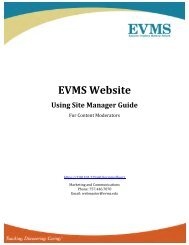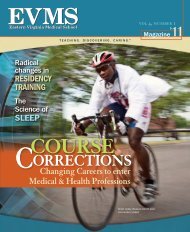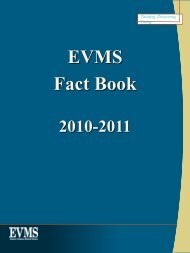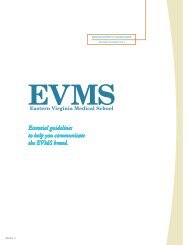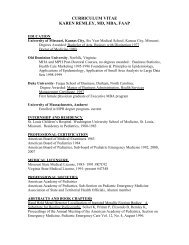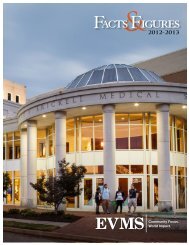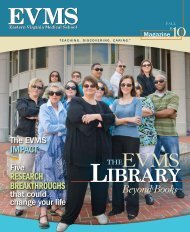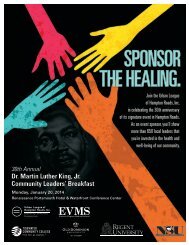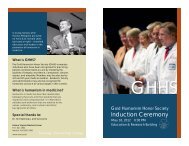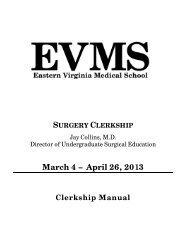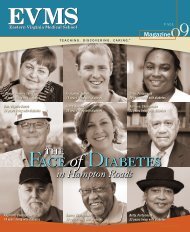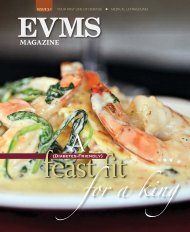Community - Eastern Virginia Medical School
Community - Eastern Virginia Medical School
Community - Eastern Virginia Medical School
You also want an ePaper? Increase the reach of your titles
YUMPU automatically turns print PDFs into web optimized ePapers that Google loves.
creditsHarry T. LesterPresidentRichard V. Homan, MDProvost and DeanClaudia E. KeenanSenior Vice President & Chief of StaffEDITORSVincent RhodesEditor-in-ChiefDirector of Marketing & CommunicationsDoug GardnerNews DirectorJennifer FrancisAccount ExecutiveAnnie PannoAccount ExecutiveDaniel ShumanAssistant Director of Marketing& CommunicationsEDITORIAL BOARDMelissa LangDirector of Alumni RelationsConnie McKenzieDirector of DevelopmentMarsha JenningsDirector of Health ServicesMarketingJohn Comerford, Joy EllinorArt DirectorsVickie Carper, Kim Cohen,Cammi MosimanGraphic DesignersJustin Crutchfield,Kim Lewandowski, Natalie SemmlerOffice of Marketing & CommunicationsSerena Amerson, Denise Cohan,Megan Christopher, Ashley Gentry, DenaListonOffice of DevelopmentCONTRIBUTORSAlison JohnsonLauren KeimLaura Neff-HendersonAlex StraussJoy VannEVMS Magazine is published three times ayear. Copies are available on campus, indoctors’ offices and by mail. To request a copyor share news, please contact Doug Gardner,News Director, 757.446.7070 or gardneda@evms.edu.941330323839Vaccinating14against feardepartmentsNewsPreparing the mental-health workforce EVMS an economic power housePediatrics chair remembered as inspirational leader New ophthalmology chairBritt earns international honors Obstetrics and Gynecology opens new location Match DayAround CampusTo Your HealthMake Your Voice CountPhilanthropyThe EVMS Capital Campaign EVMS Fund provides crucial supportDonors and scholarship recipients meetRecord gift strengthens geriatric care, modeling & simulationIn FOCUSScholarship Dinner and Reception Physician Assistant White CoatCeremony SunTrust Bank Donation Ceremony for Gerald Pepe, PhDUpcomingCover StoryEVMS Graduation 2012 — May 19 EVMS Charity Golf Classic— May 224th Annual MD Alumni Weekend — August 3-5New Student Orientation — August 13-17Wine, Women and Fishing — August 18-1920<strong>Community</strong> Care Day Major grant targets diabetes, heart disease Student blog gives peekinto medical school Study on effects of surgery smoke Executive, faculty honored by InsideBusinessAlumniThe rightman at theright timeDesperately seeking Hannah Alumnus Ron Flenner, MDIn Memoriam: Kevin G. Hegewald, MDP.O. Box 1980Norfolk, VA 23501-19802 VOL. 4 Issue 3, 2011-12www.eVMS.EDUSubscribe to EVMS Magazine – it’s free!Go to www.EVMS.edu/magazineor scan the barcode using your smart phone and any QR Reader app.
Economist James V. Koch, PhD, talks withreporters and local economic developmentofficials about his study of EVMS.Report: EVMS amongregion’s most powerfuleconomic enginesDuring a time of economic uncertainty, EVMShas bucked the trend and grown into one of theregion’s most powerful economic engines.Since 2007, the school’s annual economic impacthas grown nearly three times as rapidly as theregion’s economy, surging 18 percent to $823.6million, according to a study conducted by leadingregional economist James V. Koch, PhD. EVMSis now the 20th largest private-sector employer inHampton Roads.“EVMS has become one of the region’s mostreliable and important sources of economicgrowth,” Dr. Koch wrote in his report, releasedFeb. 14.The economic impact represents anothermeasure of the value of the school’s educational,research and clinical operations, says EVMSPresident Harry T. Lester.“Our focus has always been on doing what’sbest for the people of this region. It’s wonderful toknow that our efforts have had such a profoundimpact on the local economy,” President Lester says.“Hampton Roads is a healthier community — bothphysically and financially — because of EVMS.”EVMS commissioned Dr. Koch, a highlyrespected economist and former universitypresident, to take a comprehensive look at theschool’s fiscal impact from spending by the school,its employees and alumni, to a value assessment ofresearch and charitable care undertaken by facultyand students.EVMS alumni alone represent an importantpart of the school’s economic influence. Theapproximately 950 medical and health professionsgraduates who reside in the region’s largest citiescombine for an economic impact of $222 millionannually. Then there are the faculty, many ofwhom also see patients, who are drawn to EVMS.“The presence of EVMS continues to attracthighly qualified medical personnel that provide amenu of high-quality medical care that otherwisewould be beyond our regional grasp,” Dr. Kochcontends.With 1,379 employees, EVMS ranked 20thamong non-governmental employers in HamptonRoads in 2010. That translates into $109 millionin salaries and wages and another $21 million infringe benefits.When these employees are taken together withstudents, residents and alumni, they generate anestimated $25 million in sales tax revenue andsupport 3,752 “spin-off” jobs that are a direct resultof their combined buying power.As a not-for-profit institution dedicated to thecommunity, EVMS provides large amounts ofcharitable service and care to those unable to pay.In 2011, the estimated value of the uncompensatedhealth services provided by EVMS cliniciansexceeded $51 million. That does not includeanother $2.8 million in estimated public serviceventures, such as counseling, vaccinations andpreventive care provided annually to 100,000youths and 7,500 parents and teachers.Dr. Koch describes EVMS as “a good citizenin a fashion rarely matched in Hampton Roads.”As he did in his 2007 study, Dr. Koch exploredthe consequences if EVMS did not exist. Hepredicts that scenario would cost the region $220million and would force 98,000 patients to traveloutside Hampton Roads in search of appropriatemedical care.Without EVMS, Dr. Koch writes, the qualityof care would decline because many providerswould be missing, and the region would have todo without the medical advances that spring fromEVMS research labs.Also missing would be the 23 percent of localphysicians who have graduated from EVMS. Thatwould come at a time when a national shortage of150,000 physicians is expected by 2025.“The absence of EVMS would transform thisshortage into disaster proportions in HamptonRoads,” Dr. Koch wrote.Then there are the other benefits that EVMSbrings that are difficult to quantify.“EVMS is a caring organization dedicatedto doing good deeds and improving the humancondition,” Dr. Koch concludes.“When EVMS restores faith, reduces pain,makes individuals more productive and, yes, saveslives, indisputably this has a positive impact notonly on the affected individuals but also on theentire region.”news www.eVMS.EDU VOL. 4 Issue 3, 2011-12 5
Pediatrics chairremembered as aninspirational leaderDonald W. Lewis, MD, Chair of Pediatrics forthe last seven years and a vital part of the schoolfor nearly a quarter century, died Feb. 17.A pediatric neurologist, Dr. Lewis joined theEVMS community faculty in 1987 while still in theU.S. Navy. He came to the school and Children’sHospital of The King’s Daughters full-time in 1993.“At EVMS and CHKD, Dr. Lewis was anenthusiastic advocate for pediatric research,children’s health and quality pediatric care,” saidEVMS President Harry T. Lester and CHKDCEO Jim Dahling in a joint statement.“Dr. Lewis was an inspirational leader,” thestatement continued. “As Chair of the Departmentof Pediatrics at EVMS and Senior Vice President ofAcademic Affairs at CHKD, he was a mentor andchampion of a generation of young pediatricians.”He made a difference in countless lives.He treated thousands of children and teensfor headaches (especially migraines), seizuresand other neurological disorders. His researchadvanced the understanding and treatment ofchildren’s migraines.Dr. Lewis published more than 50 studiesand authored two books and more than a dozenbook chapters on the subject. He led the team ofneurologists who developed national guidelinesfor evaluating and diagnosing children andadolescents with recurring headaches.He was especially passionate about the dangersposed by childhood obesity and co-authored astudy that showed that the trajectory towardmorbid obesity in adolescents often begins beforea child is two years of age.He was also a gifted teacher known for hisengaging lectures on Harry Potter’s headachesand the neurological disorder that likely affectedTiny Tim, the beloved little boy from Dickens’ “AChristmas Carol.”Donald W. Lewis, MDFor seven years, Dr. Lewis served as AssociateDean for Admissions at EVMS. In 2009, EVMShonored him with the Dean’s Outstanding FacultyAward, the school’s highest recognition for faculty.On March 8, Richard V. Homan, MD, Provostand Dean, and Mr. Dahling announced that C.W.Gowen Jr., MD, associate professor of pediatricsand director of the residency program, hadaccepted the position of interim chair. A nationalsearch for a new chair is now underway.Pictured from left are Mr. Kevin O’Malley, Dr. L.D. Britt,Professor Eilis McGovern, Dr. Patrick Gullane, CountessLaura Viani and Mr. Joe Duignan.Dr. Britt earns international honorsL.D. Britt, MD, MPH, BrickhouseProfessor and Chair of Surgery, wasrecently recognized by the Royal Collegeof Surgeons in Ireland (RCSI) withan honorary fellowship. According toProfessor Eilis McGovern, MB, FRCSI,FRCS(Ed) of the RCSSI, honoraryfellowship is reserved for those who have madeoutstanding contributions to medicine, surgery orhumanity.Dr. Britt, past president of the American Collegeof Surgeons, joined a prestigious list of HonoraryFellows of the RCSI including: Her ExcellencyMary McAleese, President of Ireland; Former6VOL. 4 Issue 3, 2011-12 www.eVMS.EDU news
Dr. McCole selectedto lead OphthalmologyFor the first time in nearly three decades,the Department of Ophthalmology has newleadership.In January, Shannon M. McCole, MD,Assistant Professor of Clinical Ophthalmology,succeeded Earl R. Crouch, MD, as Chair of thedepartment. Dr. Crouch had served in the rolesince 1984.“Dr. McCole has an outstanding reputationand is well respected by her peers and colleaguesand revered by the residents for her dedication toand enthusiasm for the ophthalmology residency“Dr. McCole has an outstandingreputation and is well-respectedby her peers and colleagues andrevered by the residents for herdedication to and enthusiasmfor the Ophthalmology residencyprogram.”program,“ said Gerald J. Pepe, PhD, who madethe appointment just before he stepped down asProvost and Dean.Dr. McCole is Director of the EVMS residencyprogram in ophthalmology and Clinical Directorof the resident ophthalmology clinic in the LionsCenter for Sight at Sentara Norfolk GeneralHospital. A graduate of the Stritch <strong>School</strong> ofPresident of South Africa Nelson Mandela; thelate Mother Teresa of Calcutta; His HighnessSheikh Khalifa Bin Salman Al Khalifa, PrimeMinister, Kingdom of Bahrain; and poet andwriter Seamus Heaney.The Royal College of Surgeons of Englandalso recently awarded Dr. Britt an honoraryShannon M. McCole, MDMedicine at Loyola University, Dr. McColetrained in ophthalmology at EVMS.Dr. Pepe praised Dr. Crouch for his “stellarcareer” at EVMS. Dr. Crouch chose to stepdown as chair and remain on faculty to focus onacademic career goals and pursuits.Dr. Crouch has published more than 100 articlesand has presented at meetings of national andinternational societies. Under his leadership, thedepartment has grown substantially and hasearned national recognition.fellowship. This designation is restricted to nomore than 150 living honorary fellows.Additionally, last fall Tuskegee Universityconferred an honorary degree on Dr. Britt at the12th Annual Biomedical Research Symposium,“Passion and Compassion in Eliminating HealthDisparities.” Dr. Britt was a keynote speaker.EVMS Obstetricsand Gynecologyopens new locationEVMS Obstetrics and Gynecology recentlyopened its newest location in <strong>Virginia</strong> Beach,giving the practice three locations throughoutthe region.Located at 2075 Glenn Mitchell Road on thecampus of Sentara Princess Anne Hospital, thenew office expands the EVMS Health Servicespresence near the hospital by opening a dedicatedspace for women’s health. The facility offersservices in general gynecology, maternal-fetalmedicine, urogynecology and reproductivemedicine.“We are excited to be expanding to meet theneeds of our patients and continue to offer thebest patient experience possible,” says AlfredZ. Abuhamad, MD, Chair of Obstetrics andGynecology.The new site is one of three OB/GYN locationsin Hampton Roads, including offices in NewportNews and in downtown Norfolk. EVMS HealthServices clinicians in dermatology, surgicaloncology, plastic and reconstructive surgeryand endocrinology already share an office in thePrincess Anne Hospital complex.For more information or to make an appointment,call 757.689.5104.newswww.eVMS.EDU VOL. 4 Issue 3, 2011-127
Amrita Lalvani and Vishnu V. Ambur compare their Match Day letters.Match Day Madness 2012Zrria L. White and Sachin “Sunny” Jhacelebrate their Match Day results.Forget basketball brackets! March Madnessat EVMS was all about Match Day 2012.On Friday, March 16, fourthyearmedical students across the country toreinto their envelopes at 1 p.m. to learn wherethey matched for residency. None, however,were as stylish as the 112 EVMS students.In true “I love the ‘90s” fashion, Ninja Turtlestook the stage with boy bands, “Bay Watch”lifeguards and Vanilla Ice. Wrestling giantsStone Cold Steve Austin and The Rock threwdown their championship belts and were joinedin celebration by the Addams Family and Men InBlack.Residency encompasses the three (or more) yearsof training that are required before medical schoolgraduates can practice without supervision.Conducted annually by the National ResidentMatching Program, the match is based on acomputerized mathematical algorithm. Theprocess is engineered to produce a best result byaligning the preferences of applicants with thepreferences of residency programs in order to fillthe thousands of open training positions at U.S.teaching hospitals.Nearly 30 percent of the EVMS MD Class of2012 will train at residency programs in <strong>Virginia</strong>,including 18 here at EVMS. The remainder willspread out to civilian and military hospitals andmedical centers across the country.8 VOL. 4 Issue 3, 2011-12 www.eVMS.EDUnews
Laura Y. Huang (left), Jewel B. Osborne-Wu (center) and Sharrell N. Cooper(right) dance as the group TLC for Match Day 2012.▲ Morakinyo Akintola (left) and Andrew B.Smith are all smiles after opening theirmatch envelopes.Fourth -year MD students Omar Syed and Corey Carson lead a group ofWWF wrestling stars in an impromptu line dance at Match Day 2012.newswww.eVMS.EDU VOL. 4 Issue 3, 2011-12 9
around campusMD and Health Professions students joined forces to provide free healthscreenings and to boost health awareness and education at <strong>Community</strong> CareDay.<strong>Community</strong> Care Day 2012Grinning from beneath a mask of face paint, fiveyear-oldDamien Reid paused to give a banana-cladman a high five.“I run faster than you, banana,” he said. “And Idon’t even go to school here.”Damien was one of more than 200 visitorsdrawn to campus on a Saturday earlier thisspring for <strong>Community</strong> Care Day. MD andHealth Professions students joined forces to boosthealth awareness and education in the HamptonRoads region by hosting the event and providedimportant health screenings, health education andkid-friendly entertainment.“<strong>Community</strong> Care Day undoubtedly has apositive impact on the community around us andwill continue to do so to greater extents in thecoming years,” says Andrew K. Bolton, MPH,MD Class of 2014.Visitors to <strong>Community</strong> Care Day were offeredfree health screenings including Body Mass Index(BMI), blood pressure, blood sugar and skin cancerchecks. Students in the Physician Assistant programused fundraisers to collect more than $3,500 topurchase bicycle helmets and booster seats. Parentslined up at the booth to have their children fitted forthe free helmets. Nearby, visitors were able to toucha real brain and see the effects of smoke on lungs.Partner organizations including Sentara, OldDominion University and the <strong>Virginia</strong> Departmentof Health helped to make the event a success.“I’ve always known that EVMS was here, but Ihad no clue they did so much,” said Norfolk residentTameka Reid. “I brought my grandson to do the funthings and I got my blood pressure checked whileI was here.”The Lions Club also provided hearing and sightscreenings on campus. More than 70 people receiveda free pair of glasses during the screenings, includingNorfolk resident Marianne Harris.“It’s an incredible thing these students are doingfor the community,” Ms. Harris says. “God blessthem.”Paul F. Aravich, PhD, Professor of Pathology and Anatomy,talks about the different functions of the human brain.10 VOL. 4 Issue 3, 2011-12 www.eVMS.EDUaround campus
Major research grant targets inflammationin battle against obesity and development of heart disease, diabetesIf you are obese, you are at significant risk ofdeveloping heart disease and diabetes. Butresearch now underway at EVMS coulddrastically improve your odds of avoiding theseserious conditions.A multidisciplinary EVMS research team istargeting chronic inflammation, which scientistsbelieve triggers the development of diabetes andheart disease in people who are overweight. Theirresearch is supported by a five-year, $1.8 milliongrant from the National Institutes of Health(NIH) and may lead to ways to prevent thedevelopment of these diseases linked to obesity.“Inflammation is key to why central ‘belly’fat leads to high risks for diabetes, heart diseaseand maybe even some forms of cancer,” says JerryL. Nadler, MD, Director of the EVMS StrelitzDiabetes Center and principal investigator on thegrant.Inflammation is a double-edged sword. Theimmune system uses inflammation to battlecertain infections and heal wounds, and it subsideswhen no longer needed. But chronic inflammationcan cause problems. That’s what Dr. Nadler andhis colleagues are targeting.The EVMS scientists have preliminary evidenceshowing that excess belly fat, also known asvisceral fat, can increase inflammation in the vascularfat surrounding the blood vessels, accordingto Anca D. Dobrian, PhD, Assistant Professor ofPhysiological Sciences and co-investigator on thegrant. “The cross-talk between visceral fat, vascularfat and blood vessels is an exciting, novel conceptthat may explain better the complex relationship betweenobesity, diabetes and heart disease,” she says.The research team brings together physicians and basicscientists to try to unlock the secrets of obesity and itsstrong ties to diabetes and cardiovascular disease.Obesity — now at epidemic levels in theUnited Sates — represents a major public-healthchallenge. The risk of heart attack triples withobesity. Nearly 80 percent of people who developType 2 diabetes (often as a result of obesity) alsodevelop heart disease.To help limit the potentially deadly impacts ofthese diseases, the scientists are examining a particularchemical pathway in the body involved inchronic inflammation. Obesity activates the proteinInterleukin-12 (IL-12) that then signals a gene“switch” called STAT-4 to initiate inflammation.“As IL-12 goes up, it activates the gene switch,and we think when that is unregulated or not regulatedcorrectly, it leads to excessive inflammationaround the blood vessels and in the body. Thatcan lead to heart disease, insulin resistance andpotentially to diabetes,” Dr. Nadler says.Dr. Nadler, who also is Professor and Chair ofInternal Medicine, is leading the team of scientistson the research. Dr. Dobrian and Elena Galkina,PhD, Assistant Professor of Microbiology andMolecular Cell Biology, are also part of the team.They are collaborating with other well-knownscientists in the field, including Alan Chait, MD,from the University of Washington, and MarkKaplan, PhD, at Indiana University.The team already has strong evidence todemonstrate that by controlling STAT-4 they canprevent long-term inflammation and the diseasesthat often follow.Preliminary studies over the last two years showthat when certain mice are fed a high-fat diet, theydevelop insulin resistance (a precursor to diabetes)and atherosclerosis (hardening of the arteries thatis a hallmark of heart disease). But when scientistseliminate the STAT-4 gene, the mice do not developdisease and otherwise appear normal.“You can’t take out the gene in people, but youcan develop drugs that work the same way,” Dr.Nadler says. “We’re not preventing obesity. Thathas to be a lifestyle change. But what we are able todo is help prevent some of the damaging effects.”The researchers will use mice and donatedhuman tissue — including blood vessels and fatcells — to determine if controlling the STAT-4switch is safe and effective in preventing thedevelopment of disease. They also hope to betterunderstand how IL-12 and STAT-4 work, so theycan identify targets for drugs that would controlthe inflammation.“Right now we don’t have any treatments likethis. Nothing is on the market to target that kindof inflammation,” Dr. Nadler says. “If this works,it will open up a whole new idea of how to treatpeople with obesity, with heart disease and maybeeven prevent diabetes.”Student blog gives peek inside medical school<strong>Medical</strong> school is one of those experiences thatis hard to fully appreciate without living it. Addin the fact that each institution has its own uniquecharacter, and it becomes tough to get a feel forwhat it’s like inside those labs and lecture halls.To bridge the gap, medical school Class of2015 member Laura J. Tyrrell has been writingabout her experiences as a first-year student onEVMS’ first student-authored blog, InsideEVMS. Ms. Tyrrell covers everything from thestress of studying for basic science to the problemof managing a social life amid long hours ofstudying.Check out www.evms.edu/blogs/InsideEVMS to see how herfirst year unfolded and be sure to check back often as otherEVMS students share their stories.around campuswww.eVMS.EDU VOL. 4 Issue 3, 2011-1211
Clearing the airNew research examinessmoke in the ORA researcher at EVMS is studying the possiblehealth risks of smoke generated during surgerywith the ultimate goal of making operations saferfor doctors, hospital staff and patients.Khaled Sakhel, MD, Assistant Professor ofObstetrics and Gynecology and Coordinator forthe Institute for Minimally Invasive and RoboticSurgery at EVMS, is collaborating with a teamof Old Dominion University researchers led byPetros Katsioloudis, PhD, Director of the school’sIndustrial Technology Program. The multi-yearstudy, now in its early stages, will test a variety ofsurgical instruments, including lasers, ultrasoundand cauterization.The first phase of the study began last fall andwill calculate the amount of smoke producedby each instrument using a specially-designedmeasurement device. The second phase willexamine exactly what chemicals and othersubstances — possibly including blood particlesand viruses small enough to get through surgicalmasks — are in the smoke and how they mightaffect anyone in an operating room.“The risks of surgical smoke really aren’twell known by many people, including doctorsand hospitals,” Dr. Sakhel says. “Our ultimategoal through this research is to develop filteringrecommendations to minimize surgical smokeexposure for health-care workers.”Researchers already know that surgical smokecontains a number of cancer-causing substances,including hydrogen cyanide, benzene andformaldehyde. The chemicals also can irritateairways, worsen asthma and possibly cause chroniccoughs, headaches and fatigue. Surgeons, whomight perform thousands of operations in theircareers, likely would be most at risk.In addition, case reports have documentedtransmission of the human papillomavirus (HPV)from patient to surgeon. Conceivably, tiny bloodEVMS executive, faculty honoredIn recent months, the local publication Inside Business has honored sixmembers of the EVMS family.The recognition began when Claudia E. Keenan, Senior Vice President andChief of Staff, was selected among the magazine’s Women in Business honorees.The publication honored Ms. Keenan for her work to rejuvenate the school’smarketing, communications, development and alumni relations programs.In February, five faculty were honored as Health Care Heroes:Terri W. Babineau, MD, Director of <strong>Community</strong> Outreach and a graduateJean Shelton, MD, was one of five faculty members celebrated as a Health Care Hero by thepublication Inside Business in February. Pictured with her are, center, event sponsor Hal Levine,MD, of Value Options, and Inside Business Publisher Ed Powers.Khaled Sakhel, MDparticles could transmit the human immunodeficiencyvirus (HIV), as well, Dr. Sakhel says.Solutions could include better filtering, alongwith vacuum and ventilation systems, inoperating rooms as well as limiting the amountof smoke generated. As the study progresses, Dr.Sakhel expects to attract statewide interest and,hopefully, a variety of grants. “With so manydifferent surgical modalities available today andso little written about the safety of surgicalsmoke, I think we’re just at the tip of the icebergnow,” he says.of EVMS, received the Primary Care Physician award for her efforts tofacilitate student involvement in the community, such as the HOPES Clinic,the first student-run free clinic in <strong>Virginia</strong>.W. Thomas Bass, MD, Professor of Pediatrics, received the award forAdvancements in Health Care. Dr. Bass, a neonatologist at Children’s Hospitalof The King’s Daughters (CHKD), was part of a team that pioneered atechnique to reduce the chance of long-term brain damage among childrenwho experience brain trauma during childbirth.Edward H. Karotkin, MD, Professor of Pediatrics, received the Pediatricianaward. Dr. Karotkin, a neonatologist at CHKD, was honored for his workwith Physicians for Peace.Jean E. Shelton, MD, Professor and former Chair of Physical Medicineand Rehabilitation, received the award for Physician Specialist. Dr. Sheltonhas dedicated her life to develop services for children with disabilities andtraumatic injuries. She holds the Lydia I. Meyers Endowed Professorship inPhysical Medicine and Rehabilitation.Thomas R. Pellegrino, MD, was presented a posthumous award recognizinghim in the category Health Care Leader. Associate Dean for Education at thetime of his death in 2011, he was celebrated as the consummate educator, evenusing his own battle with cancer as a learning opportunity for students. His wife,Jane Pellegrino, was on hand to accept the award on behalf of the family.Check out www.evms.edu/magazine for other Health Care Heroes photos.12VOL. 4 Issue 3, 2011-12www.eVMS.EDUaround campus
to your healthMake yourvoicecountJohn T. Sinacori, MD,Assistant Professorof Otolaryngology-Head and Neck Surgery,is Director of the EVMSVoice and SwallowingCenter. He specializes indiagnosing and treatinga wide variety of voice John T. Sinacori, MDdisorders that affect bothprofessionals and the general public. The Voice Centeralso treats patients with swallowing problems. Manyailments that affect the voice can also cause difficultywith swallowing.What are some common problemsthat can cause hoarseness?Acute laryngitis is the most common cause of hoarsenessand sudden voice loss. Usually, this is caused by aviral infection that leads to swelling of the vocal folds.When they swell, they vibrate differently, so your voicesounds abnormal or raspy. The best way to treat this isto stay well hydrated with water and reduce your voiceuse or completely rest your voice if possible. If a runnerhurts his knee, he doesn’t go out running the next day.He rests and recovers. We just don’t think of our voicesthat way, so most people continue to use them whenthey are already weak or hurt, which can lead to morechronic problems. An otolaryngologist should evaluateany hoarseness lasting more than two to three weeks.Can I overuse or misuse my voice?Absolutely. Speaking is a physical task that requirescoordination of breathing with the use of several musclegroups. As in any other physical task, there are efficientand inefficient ways of using your voice. Excessivelyloud, prolonged and/or inefficient voice use can leadto vocal difficulties. This can lead to excessive muscletension in the neck and poor breathing, which can resultin chronic hoarseness. This may be common amongteachers and business professionals. In this world ofcommunication where we are always on the phone, ourvoices never get a break, so almost anyone can overuseor misuse his or her voice.What are some common situationsthat are associated with voice misuse?n Speaking in noisy situations.n Excessively using a cell phone.n Cradling a telephone handset to the shoulder. Thisputs your larynx and muscles in an unfavorable positionwhile speaking.n Using inappropriate pitch — too high or too low —when speaking.n Not using amplification when publicly speaking orwhen speaking in a room with lots of backgroundnoises.Can reflux cause voice problems?Reflux of stomach juice into the throat can causemany different symptoms. Most people think ofreflux as just heartburn, but reflux can cause chronicthroat clearing, a feeling of something stuck in yourthroat especially after swallowing, bad breath, chroniccoughing, hoarseness and a feeling of thick mucous thatsome mistake as post-nasal drip. If you have any ofthese symptoms, then you may have reflux without everhaving heartburn and should set up an appointmentwith an otolaryngologist.When should I see a doctor for my voice problemand what type of doctor should I see?Since the most common cause of hoarseness is acute— lasting less than two weeks — laryngitis from aviral condition, most people do not need to seek aprofessional. However, if your hoarseness lasts morethan two weeks, you should follow up with yourprimary-care physician. New guidelines publishedon the treatment of hoarseness indicate that antibioticsdo NOT help with laryngitis. Your physician shouldreiterate appropriate hydration and voice rest. If yourhoarseness persists more than two weeks without anysigns of improvement, then you should seek anotolaryngologist who can directly evaluate your vocalfolds. Hoarseness in a smoker is certainly more urgentbecause of the concern for cancer. A laryngologist, likeme, is someone who has had an extra year of trainingspecifically in voice disorders and may be helpful ifyour hoarseness persists.To learn more about The EVMS Voice and Swallowing Center,call 757.388.3200.TO YOUR HEALTHwww.eVMS.EDU VOL. 4 Issue 3, 2011-1213
VaccinatingAgainstFear14 VOL. 4 Issue 3, 2011-12 www.eVMS.EDUvaccinating against fear
16 VOL. 4 Issue 3, 2011-12 www.eVMS.EDUvaccinating against fear
What happens when fear ofthe cure becomes strongerthan fear of the contagion?Vaccines were so successful over the last century thatparents stopped being afraid of diseases and startedbeing unnecessarily afraid of vaccinations, EVMSexperts say.The ensuing debate has led some parents to decideagainst vaccinating their children, which hasallowed certain illnesses to creep back into thecountry. Two of the most contagious diseases, pertussis(commonly known as whooping cough) andmeasles, have led the way, with cases increasing in<strong>Virginia</strong> and nationwide.“We’re setting ourselves up for outbreaks ofdiseases that are completely preventable,” saysEdward C. Oldfield III, MD, Professor of InternalMedicine and Director of the Division of InfectiousDisease. “All people talk about are side effects ofvaccinations, which in reality are extremely rare.They forget the terrible risks of these diseasesthemselves.”EVMS experts are actively working todispel myths and inflammatory reports aboutvaccinations, which most often cause only mild,temporary side effects, such as fever and tendernessat the inoculation site. The medical school and the<strong>Virginia</strong> Department of Health also are partnerson Project Immunize <strong>Virginia</strong>, which promoteson-time vaccination for both children and adults.Vaccinations are credited for wiping out smallpoxand polio and nearly eliminating measles and rubellafrom the United States. Inoculations for diphtheria,mumps, whooping cough and tetanus have led to a92 percent reduction in each illness and a 99 percentreduction in deaths from those diseases over the pastthree decades. Shots for hepatitis A and B, influenzaand chickenpox, all introduced since the 1980s, havedecreased related infections and deaths by morethan 80 percent. Rotavirus vaccination, introducedin 2006, essentially eliminated exposure to the virusby 2010 in North America.Preventing outbreaks, however, requires a “herdimmunity” of at least 90 percent, and ideally morethan 95 percent, Dr. Oldfield says. The UnitedStates has cut it close on some vaccines in recentyears. In 2009, 90 percent of children had receivedthe two recommended doses of the measlesmumps-rubellashot by age three, a number thatclimbed to 91.5 percent in 2010, according to theCenters for Disease Control and Prevention (CDC).Opting against vaccination can be dangerous,especially for vulnerable populations such as youngchildren, the elderly and persons with chronicdiseases and compromised immune systems,EVMS experts say. Take measles as an example.As of late October 2011, doctors had diagnosed 223cases nationwide, up from 61 cases in 2010 and thehighest number since 1996, when there were 508cases. Of those 223 patients, 87 percent had notbeen vaccinated as recommended. Many pickedup the virus overseas, where it is more commonthan people imagine; Europe had more than 26,000cases and nine deaths in the first six months of 2011alone, according to the World Health Organization.“Whooping cough has become particularlydifficult to manage,” says David O. Matson,MD, PhD, Professor of Health Professions andPediatrics. “Like measles, as fewer cases haveoccurred, recognition of the disease is less frequent.Whooping cough has occurred in two of the churchchoir members with whom I sang. Only one ofthem was aware that was what he had.”Decades ago, families lived in terror of contagiousdiseases that could cripple or kill. Infected peoplelived in isolation or in special hospital wards. Butthat’s been so long ago that people have forgottenthe dire consequences. Instead, fear of rarecomplications has given birth to pervasive myths.vaccinating against fear www.eVMS.EDU VOL. 4 Issue 3, 2011-1217
serious complications. “A lot of science went into selecting the timingof these,” Dr. Lewis said. “We give vaccines when they are mosteffective.”Even though children might get some 30 shots before they’re teenagers,the total amount of antigens — toxins or foreign substances that provokean immune system response — represents only a fraction of those onceincluded in a single smallpox vaccine, Dr. Lewis added. “The older shotsweren’t nearly as purified,” he said. “The shots today are so much betterthan they were even 10 or 15 years ago.”Adults also should follow immunization guidelines recommendedby their physicians and national health organizations, EVMS expertssay. Based on their vaccination records and health history, occupationor lifestyle, adults might need immunizations or boosters for MMR,DPT, HPV, varicella, meningitis, pneumonia, hepatitis A and B andmore in addition to annual flu shots.“The safety profile of a vaccine can be well established with the largestudies conducted before licensure, as well as the post-licensure studiesthat include thousands of vaccine recipients enrolled at centers withcomputer databases,” Dr. Matson says. “Such studies easily find adverseevents at rates of 1 in 30,000, or even rarer events when such eventsoccur.”The bottom line isthat prevention is far lessrisky than contracting thedisease.Inoculations have been“the greatest public health success storyin the history of medicine,” Dr. Lewis said.As time has passed, the well -founded fear of childhood diseases likepolio and measles has been replaced with an unfounded fear of thetechnology (vaccines) that eliminated those scourges, saysDr. Oldfield. “Unless we maintain very high levels ofvaccination, we will begin to see the return of theseforgotten diseases.”Our Panel of ExpertsDonald W. Lewis, MD: Untilhis sudden death in February of this year, Dr.Lewis was a Professor of Pediatrics and Chairof the Department of Pediatrics. A pediatricneurologist at Children’s Hospital of The King’s Daughters, Dr.Lewis was an enthusiastic advocate for pediatric research, children’shealth and quality pediatric care.David O. Matson, MD,PhD: Dr. Matson is a Professor ofHealth Professions and Pediatrics and formerDirector of infectious diseases in pediatrics.Dr. Matson was principal U.S. investigator in one of the nation’slargest pre-licensure clinical trials, a study that resulted in FDAapproval of the vaccine Rotateq for rotavirus.Edward C. Oldfield, MD:Dr. Oldfield is Director of the Division ofInfectious Diseases at EVMS. During acareer in the U.S. Navy, Dr. Oldfield servedas specialty advisor on infectious diseases to the Navy SurgeonGeneral. The Institute of Medicine appointed him to its Gulf Warand Health: Infectious Diseases Committee.new spaces www.eVMS.EDU VOL. 4 Issue 3, 2011-12 19
Richard V. Homan, MDProvost & Dean20 VOL. 4 Issue 3, 2011-12 www.eVMS.EDUrichard v. homan, md
“For me it’s always been about making thebiggest impact with everything I do andalways, always helping others.”22 VOL. 4 Issue 3, 2011-12 www.eVMS.EDUrichard v. homan, md
“It was never in my plans to be a dean of a medicalschool; it was something I evolved into during mycareer,” he says. “For me it’s always been aboutmaking the biggest impact with everything I doand always, always helping others.”Once the only family-medicine doctor at thehelm of a U.S. medical school, Dr. Homan is stillone of only a handful of primary-care physiciansto ascend the ranks in academic medicine.It’s 5:30 p.m. on a Wednesday.Dr. Homan is standing at his second-floor officewindow studying the campus. He has two moremeetings and an event scheduled before he canhead home. Still, the view of a bustling medicalschool has captured his attention for a few shortminutes.“I can throw a baseball from my officewindow and hit the wall of the only children’shospital in <strong>Virginia</strong> — that’s amazing,” he says.“The partnerships we have, the great educationalfacilities all in one campus, people directingenergy toward developing the next generation ofscientists and health-care providers — the piecesare in place for this institution to become betterknown nationally.”Dr. Homan recognizesopportunity, dedication andstrength when he sees it.In many ways, his belief system and dedicationto community-focused medicine was formedearly in his career at the White River IndianReservation in Arizona. There, he was immersedin a culture unlike anything he had experiencedbefore and was on the front lines of medicine ina rural community 200 miles from the nearestWalMart.He treated children, adults, trauma cases andcomplicated pregnancies. He sent many patientsto Phoenix and taught students from across thecountry about how to care for every patient thatcame through the door.“It was an adventure being the only Anglo inthe post office or little grocery store, but it was alsoa great lesson in how to cross cultural barriers andprovide quality health care in a respectful way,”Dr. Homan says.Other formative lessons came later in Texas,where he went on a five-year plan and ended upstaying for 16. During that time, he rallied thelegislature and built a new medical school out of asatellite campus.As he grew professionally, so did thechallenges he tackled. In Philadelphia he steppedin to lead a medical school that had emergedfrom bankruptcy. Drexel <strong>School</strong> of Medicinewent through four deans in five years and manyfaculty. It was a risk, but one worth taking fora man who says he “gets uncomfortable whenthings get comfortable.”During his tenure, he recruited new chairs andvice deans, developed leadership infrastructure,turned around the finances and stabilized theacademic and research programs.“After six years at a frenetic pace in thecity, you start to become frenetic, and I hadaccomplished what I had gone to Drexel to do,”he says. “I was ready to find a place I could stayat long term and eventually retire.”After all, he says, “I want to die with astethoscope around my neck.”If Drexel was a leap, then EVMS was aperfect fit.richard v. homan, md www.eVMS.EDU VOL. 4 Issue 3, 2011-1223
“He is very bright and fullyunderstands the complexities ofour health-care environment andthe three missions of EVMS —teaching, discovering, caring.I see a great future for EVMSwith Dr. Homan as our leader.”Jerry L. Nadler, MD,Chair of Internal MedicineIn EVMS, he saw a medical school where hecould make a difference and a community hecould call home. But perhaps the most appealingwas EVMS’ strong focus on the community. Itwasn’t a difficult decision.“At the heart of it all, I am a primary-carephysician, which means I see how helpingpatients can, in turn, help their family and thecommunity, and that through our work wecan make a difference,” he says. “The students,faculty and staff at EVMS recognize how theycan impact health care in Hampton Roads, theCommonwealth of <strong>Virginia</strong> and the world. It isexciting to be a part of something like that.”The civility of the south and proximity of theocean didn’t hurt when convincing his wife tomove. “It’s like Texas on the beach,” he says.Within hours of the announcement of Dr.Homan’s appointment to the EVMS helm, JudithRobinson Mercer’s email box began filling up.Mrs. Mercer, Associate Dean for Library andLearning Resources and Director of EducationalTechnology for the Edward E. Brickell <strong>Medical</strong>Sciences Library, was overwhelmed with “luckyyou” messages from professionals across thecountry.“I had countless emails and phone calls fromcolleagues around the country telling me ‘youwill love working with him,’” Mrs. Mercersays. “Whether faculty and staff at his earlierinstitutions or professional collaborators thatworked with him on committees or groupswithin the American Association of <strong>Medical</strong>Colleges, all described a man of vision and energywho understands the health-sciences educationalenvironment and is a great leader.”Just a few months in and he is already livingup to his reputation, she says. “I am delighted tosay that everyone was right, and I believe we willflourish under his guidance,” Mrs. Mercer says.Jerry L. Nadler, MD, Chairman of InternalMedicine, agrees.“He is very bright and fully understands thecomplexities of our health-care environmentand the three missions of EVMS — teaching,discovering, caring,” Dr. Nadler says. “I see agreat future for EVMS with Dr. Homan as ourleader.”Today, Dr. Homan is touringa handful of buildings and offices on campus thatare on his list of must-sees. He moves along thehallways nodding and calling people by name ashe passes — a man clearly on a mission.24 VOL. 4 Issue 3, 2011-12 www.eVMS.EDU richard v. homan, md
He checks out available lab space at LewisHall, stops in for impromptu conversations witha select number of directors and departmentchairs and does a top-to-bottom walk throughof Smith Rogers Hall. He’s energetic, polite andfires off questions:“What size is this lab?”“What research goes on here?”“What departments are in this building?”“Who works on this floor?”He stops to write something down in his notebook,then moves on. He’s processing and thinkingforward — always planning for what’s next.He’s bound for a meeting with a group ofstudents in 20 minutes to discuss their ideas abouthow to advance the campus. These are the thingshe lives for — so much so, he started meetingwith students before he even was on campusofficially as the dean.John E. Prescott, MD, Chief Academic Officerof the Association of American <strong>Medical</strong> Colleges(AAMC), has witnessed Dr. Homan’s professionalgrowth over the past several years. Dr. Prescottoversees AAMC efforts designed to prepare andassist deans, faculty leaders and future physiciansfor the challenges of 21st century academicmedicine. Dr. Homan’s work on the Council ofDeans has earned him national attention.“I can think of few people who are as devotedto medical education, research and clinicalcare, as well as committed to community as Dr.Homan,” Dr. Prescott says. “EVMS has gainedsomeone who will listen carefully, formulate aplan of action seeking input from his faculty andsomeone who can execute on that plan.”Dr. Homan was nominated to be one of 20LCME accreditors in the country — a positionthat would have put him in position to directlyimpact how, and if, medical schools earn theiraccreditation. It’s a highly sought-after positionhe turned down to accept the job at EVMS.After his installation, students were among those eager tospeak with Dr. Homan about the future of EVMS.“He will do great things complementingthe ground work that others — PresidentLester, Dean Pepe — laid before him,” Dr.Prescott says. “There is little doubt in my mindthat he will take EVMS to places it has neverbeen before to better serve the community andthe nation.”Also, Dr. Prescott says, he’s just a wonderfullynice guy.Dr. Homan speaks at a recent reception that brought togetherscholarship recipients and donors.richard v. homan, mdwww.eVMS.EDU VOL. 4 Issue 3, 2011-1225
Fetal Surgeryat EVMSLifesaving Carefor theTiniest PatientsMaternal-fetal medicine specialist Jena L. Miller, MD26 VOL. 4 Issue 3, 2011-12 www.eVMS.EDUfetal surgery
Have trouble threading a needle?Imagine using a laser the size of a piece of threadto perform lifesaving surgery on an unborn childvery expectant parent dreamsE of a smooth pregnancy, an easydelivery and a healthy infant. But for 10to 15 percent of pregnant mothers, thosedreams are clouded by fear and worry.That’s because they are more likely to needmedical or surgical intervention due toan underlying condition in themselves ortheir unborn children. Although they planand prepare like other parents, they mustdo it while living with the unsettling label“high risk.”“It can make for a pretty high-anxietypregnancy,” says Maternal-Fetal MedicineSpecialist Jena L. Miller, MD, who providesadvanced specialty care for these mothersand babies as part of the comprehensiveMaternal-Fetal Medicine Program atEVMS. “A lot of what we do is monitor andcounsel patients to help them understandexactly what is happening.”When high-risk patients do need surgicalintervention, time is critical. In thepast, the sickest patients often had to betransported far from home to specialtycenters in Maryland, Pennsylvania orFlorida, increasing anxiety and potentiallydelaying treatment.But thanks to a new Fetal Surgery Programthat’s a cooperative venture of EVMS andSentara, many of these patients can nowget the highly advanced specialized carethey need close to home.“EVMS is already nationallyrecognized for expertise in prenatalultrasound and prenatal diagnosis, soadding a fetal surgery program was anatural extension of our expertise anda natural next step for our Maternal-Fetal Medicine practice,” saysAlfred Z. Abuhamad, MD, Chair ofObstetrics and Gynecology.Fetal surgery at EVMS not only allowsfor faster treatment when hours count,but also keeps them closer to home andfamily support when they need it most.fetal surgery www.eVMS.EDU VOL. 4 Issue 3, 2011-1227
When CareCan’t Wait“ . . . the umbilicalcord is about2 mm, soyou have to beextremely precise.”Jena L. Miller, MD, Maternal-Fetal Medicine SpecialistFetal surgery is the last resort for babies who have run outof options. The Fetal Surgery Program at the <strong>Eastern</strong><strong>Virginia</strong> <strong>Medical</strong> Center, a collaboration between EVMSMaternal-Fetal Medicine and Sentara Healthcare,provides cutting-edge treatments for life-threateningconditions. In addition, Pediatric Specialists fromCHKD will provide medical and surgical expertise ina comprehensive model care.“There are a handful of conditions, such as Twin-to-Twin Transfusion Syndrome (TTTS), which, if you don’taddress them before birth, will seriously jeopardize the lifeof the fetus,” says Dr. Abuhamad. “Without intervention,the fetus would either die or the quality of life would be seriouslyaltered.”A fetal surgery program addresses conditions such as TTTS using theleast invasive and most advanced methods possible, says Dr. Miller, whowas fellowship trained in maternal-fetal medicine at the University ofMaryland <strong>Medical</strong> Center, home to the Center for Advanced FetalCare, and has a particular interest in the challenges of complicatedtwin pregnancies.“A lot of patients are actually quite shocked to learn the risks,”says Dr. Miller. “They think ‘Oh, we’re going to have twins. It’sgoing to be great!’ I tell patients that you can’t really feel relaxeduntil you are holding both of those babies at the end.”The Fetal Surgery Program is one of only about 20 similarprograms nationwide. While it can’t take away all the anxiety of adifficult pregnancy, Dr. Abuhamad says having such an advancedprogram close to home should be reassuring for <strong>Virginia</strong>’s highriskmothers and babies.Fetal InterventionsFetal surgery is no easy task. Because of the small spaces inwhich doctors have to work, they often use small tools, fine needlesand ultrasound or a special camera called a fetascope for guidance.To hone her skills, Dr. Miller spent a month in the Fetal MedicineFoundation at King’s College Hospital in London, England, andanother month at Necker hospital de L’Enfant Malade in Paris, France,studying precision techniques like fetal endoluminal tracheal occlusion(balloon placement) for congenital diaphragmatic hernia and lasersurgery for TTTS.“It can be extremely challenging,” says Dr. Miller. “The vessels arequite small and you don’t always know exactly where they’re located until you see theplacenta. Everyone’s anatomy is different. In a twin case, the fetuses are both moving,so they often get right in your way. And the mom is usually awake, so you also have28 vol. 4 issue 3, 2011-12 www.eVMS.EDUfetal surgery
her position to consider. There is a lot going on and it is easy to get disorientedwithout a lot of concentration and preparation.”Twin-to-Twin Transfusion SyndromeTTTS is a serious complication that occurs in as many as 35 percent of allU.S. monochorionic pregnancies — in which one or more fetuses share a singleplacenta. In some cases, connecting blood vessels within that placenta allowblood to pass from one twin to another, leading to disproportionate blooddistribution. High blood volume in one baby may strain its heart, raising therisk of heart failure, while low blood volume in the other twin can seriouslystunt development.TTTS accounts for an estimated 17 percent of all fetal deaths in twins. Anadvanced procedure called selective laser photocoagulation helps to distribute theblood more evenly. Performed when babies are no bigger than the size of yourpalm, the procedure offers many of them their best chance of survival. EVMSwill begin offering the delicate procedure later this year.Fetal AnemiaCaused by fetal infection or antibodies in the mother’s blood, fetal anemiacan lead to serious developmental problems in utero. New medications havereduced the incidence of the condition, but severe cases may still require surgery.To counter low-blood count and avoid premature birth, EVMS maternal-fetalmedicine specialists offer intrauterine transfusion, a procedure during whichred blood cells are given through a tiny needle placed in the umbilical cordwith ultrasound guidance.“At this point in pregnancy, the umbilical cord is about 2 mm, so you haveto be extremely precise,” says Dr. Miller.Fetal Pleural EffusionsAbnormal fluid accumulation in the chest — called fetal pleural effusion— requires a different approach. While some cases may clear up on their own,unchecked pleural effusion compresses and damages developing lungs and evencauses fetal heart failure. When cases are severe enough to need treatment, excessfluid may be drawn off with a needle guided by ultrasound.Because it plays a role in both diagnosis and intervention, the state-of-the-artEVMS ultrasound unit is a vital part of the fetal surgery program. The unitincludes eight-color doppler ultrasounds, as well as a 3D machine, and is staffedby seven full-time registered diagnostic medical sonographers with extensiveexpertise in high-risk obstetrical ultrasound.“Thankfully, many of ourcases just require veryclose monitoring, but forpatients who do need ahigher level of care, weare glad to be able to nowoffer potentiallylifesaving interventions.”Jena L. Miller, MDBladder Outlet ObstructionAnother potential high-risk complication is the development of a bladderoutletobstruction, which occurs in approximately one in 5,000 pregnancies.Left untreated, an improperly working urinary system can cause urine to backup and cause irreversible kidney damage. In severe cases, EVMS specialists mayrecommend a fetal shunt to drain the urine.fetal surgery www.eVMS.EDU vol. 4 issue 3, 2011-1229
alumniDesperately Seeking HannaFormer patient helps EVMS grad secure $2 million research grantIn the highly-competitive world of medicalresearch where promising ideas far outstripthe funds available to pay for expensivestudies, one EVMS graduate has defied the odds.Hanna K. Gaggin, MD, MPH, earnedher medical degree in 2003 and continued tobuild on her knowledge. She completed herresidency at the University of <strong>Virginia</strong> HealthSystem, earned a Master of Public Health fromHarvard University <strong>School</strong> of Public Healthand undertook cardiology fellowships at theUniversity of Pittsburgh <strong>Medical</strong> Center andMassachusetts General Hospital.Stirred by her experiences at EVMS, Dr. Gagginmaintained an interest in research — specifically,in congestive heart failure. Her commitment toexcellent care has opened the door to expandingher research.Dr. Gaggin was moonlighting at FalmouthHospital in Massachusetts when she treated awoman who was very ill.“I spent a lot of time with her and her family.I just did my job and took time to explain whatwas going on and to plan with other doctors,” Dr.Gaggin says. “She got better, wrote a very nice thankyou note, and we lost touch.”Several years later, Dr. Gaggin learned that herformer patient was looking for her. The patientwanted to discuss how her family foundation couldhelp with Dr. Gaggin’s research.Over the following year, Dr. Gaggin workedHanna K. Gaggin, MDwith the woman to refine her research plan andnavigate the grant application process. Dr. Gagginwas touched by the woman’s generosity andthrilled with the rapid approval of the proposalfor a $2 million research grant.“To have the foundation actively pursuing andfinding me is incredible,” she says. “I would neverhave expected a patient to come back and supportme and my research. It’s like something you seeon TV.”Dr. Gaggin’s research focuses on refining ablood test that measures a hormone releasedduring congestive heart failure. There is evidencethat this hormone, or “biomarker,” may be foundin the blood of patients early in the course of thedisease, a prospect with far-ranging implicationsfor treatment and management.Dr. Gaggin attributes her interest in researchto her time working on sleep-related studies atEVMS with Robert D. Vorona, MD, <strong>Medical</strong>Director of the Division of Sleep Medicine, and J.Catesby Ware, PhD, Division Director.“They were incredibly supportive and treatedme like a colleague,” Dr. Gaggin says. “It got meaddicted to research and coming up with ideas andnew methods to treat patients.”Dr. Vorona says he was impressed by Dr.Gaggin’s commitment to research despite thedemands of her medical education.“I’m always surprised when someone is awardedsuch a remarkable gift. But if a philanthropistwould be impressed by the intellect, wonderfuldisposition and demonstrated hard work ofsomeone, it doesn’t surprise me that it would beHanna,” he says.Dr. Gaggin is now at Massachusetts GeneralHospital. In July, she will join the Harvard<strong>Medical</strong> <strong>School</strong> faculty as a clinical instructor. Sheis leading two biomarker clinical trials.Throughout her career, Dr. Gaggin’s goalto marry bedside treatment with cutting-edgeresearch has remained steadfast.“I love seeing patients as much as I love doingresearch. It’s from taking care of patients that I getresearch questions,” she says. “I don’t ever want tobe out of touch in taking care of patients.”Class NotesRolando J. “Rolo” De Leon MD ’82, becameChief of the <strong>Medical</strong> Staff at Mercy Hospital inMiami, Fla., effective Jan. 1.“I know that whatever I have achieved is entirelydue to the formative education that we receivedduring those early EVMS years,” Dr. De Leon says.Sharing a table at a holiday cocktailparty where Hampton Roads alumnilearned about opportunities tosupport EVMS are, from left, C. StokesKirkland, MD ’81, and Janis Kirklandalong with Michael Joyner and his wifeChristian Joyner, MPA ’06.Have you updated your Alumni profile lately? Visit www.evmsAlumni.com to make sure your information is current.30 VOL. 4 Issue 3, 2011-12 www.eVMS.EDUalumni
In Memoriam:Kevin G.Hegewald, MDRonald W. Flenner, MD, Associate Dean for Education andAssociate Professor of Internal Medicine, discusses patientcare with fourth-year medical student Heather Barton.Alumnus Ron Flenner reflects on hisnew leading role in medical educationRonald W. Flenner, MD, Associate Professorof Internal Medicine, was appointed AssociateDean for <strong>Medical</strong> Education in November. A1989 EVMS graduate and faculty member at theschool for the last 16 years, he continues to see somepatients but is transitioning away from his role asstudent clerkship program director. He took a fewminutes from his busy schedule to talk about hisnew role.Q What does your position entail?A The vast majority of what I do is oversightof medical education and the evaluation andmanagement of curriculum and student progress.That involves interfacing with individuals in theOffice of Student Affairs, and I work closelywith the <strong>Medical</strong> Education Committee withrepresentation from first- and second-year coursedirectors, third-year clerkship program directors,medical students and other faculty, includingresidency program directors. I’ve also retainedAlumni InformationSend your class notes and news to Alumni@evms.eduSavethedate:May 11, 2012White CoatRetirementCeremony.some patient-care responsibilities, both outpatientand in the hospital.Q What are the challenges in establishing andmaintaining an appropriate curriculum?A The challenges we face are not unique to thisschool. The challenges, in part, are based on thecomplexity of the medical system and the changesthat occur at a rapid rate. Students entering medicalschool come with expectations of more timedevoted to self-directed study and online learningand decreased medical lectures. They also expectsmall-group discussions led by peers and facultywith increased use of information technology,modeling and simulations. Small groups, whichbenefit students greatly, rely on faculty whose timeand resources for their own practice and researchhave been diminished. Finding time for them tolead small groups is difficult. In addition to ourfull-time faculty, we also rely on volunteer andContinued on page 39August 3-5, 2012MD Alumni ReunionWeekend celebrating theclasses of 1977, 1982, 1987,1992, 1997, 2002, 2007.October 26, 2012Annual <strong>School</strong> of HealthProfessions AlumniBanquet, EVMS campus,6-8 p.m.The EVMS community lost a respectedmember when alumnus Kevin G. Hegewald,MD, died in September 2011 after a valiantfight with cancer. He was 43.After graduating from the University ofUtah, Dr. Hegewald earned his medicaldegree from EVMS in 1997. He completedresidency at Loma Linda University and forthe past 11 years worked as an emergencyroom physician in San Clemente, California.The father of four was dedicated to hisfamily and faith. He was an avid outdoorsmanwho introduced his children to fishing, skiing,climbing, biking and surfing. He was acounselor and served a two-year mission inGermany as a member of The Church ofJesus Christ of Latter-Day Saints.Classmates remember Dr. Hegewaldwarmly.“Kevin faced every challenge with a smileand a kind word,” says Daniel A. Neumann,MD, a fellow member of the Class of 1997.“He helped each of us buffer the ups anddowns of medical school and life with hissubtle humor and refreshing perspective. Hebalanced his education and family life whilestill making time to play on our intramuralsports teams and socialize.”His wife of 19 years, Abby, and his children,Joshua, 16, Sophie, 14, Benjamin, 10, andSamuel, 7, survive Dr. Hegewald.To learn more and register for these events, please visit www.evmsAlumni.com.alumniwww.eVMS.EDU vol. 4 issue 3, 2011-1231
philanthropyThe EVMSCapital Campaign:20/Twenty Vision of a Bright FutureA projected image announces “The Future is Now” across the front of the Educationand Research Building during the ribbon-cutting ceremony for the structure.32 VOL. 4 Issue 3, 2011-12 www.eVMS.EDUPHILANTHROPY
The new building has provided much needed research space anda home for the Leroy T. Canoles Jr. Cancer Research Center.“We’re creating moreopportunities for futurehealth-care providers andconfronting chronic diseasesthat affect our family andfriends. With the communityby our side, we’re ready totake the next step towardexcellence across theinstitution.”Harry T. Lester, PresidentPropelled by a groundswell of support fromthe community, EVMS is moving intothe final phase of its 20/Twenty CapitalCampaign, having already exceeded its goal.The campaign positions EVMS for the futureby providing financial resources for constructionand renovations, critical research programs,scholarships and endowments. EVMS launchedthe 20/Twenty initiative in 2009 with a $25million goal. With the rest of 2012 still to go, thecampaign already has topped that mark. And it’sstill growing.“People in Hampton Roads understand theimportance of supporting EVMS,” PresidentHarry T. Lester says. “We’re creating moreopportunities for future health-care providers andconfronting chronic diseases that affect our familyand friends. With the community by our side,we’re ready to take the next step toward excellenceacross the institution.”The campaign’s achievement is good news —not just for EVMS, but for all of Hampton Roads.The “20/Twenty” title is not just a reference to theclarity of EVMS’ vision; it also denotes the yearthat the growing Baby Boomer population couldoverwhelm the health-care system.PHILANTHROPYwww.eVMS.EDU vol. 4 issue 3, 2011-1233
“EVMS is really a ‘by the community, for thecommunity’ kind of organization. In many ways, theCapital Campaign is about improving the community.”Claudia E. Keenan,Senior Vice President and Chief of Staff“EVMS is really a ‘by the community, for thecommunity’ kind of organization,” Senior VicePresident and Chief of Staff Claudia E. Keenansays. “In many ways, the Capital Campaign is aboutimproving the community.”The impending shortage of physicians willdirectly impact everyone in the area — whetherit’s in the form of delays in a doctor’s office or lackof access to specialty care. EVMS was establishedin 1973 to improve the region’s health care. Trueto its roots, the school is addressing the threat of ashortage head on by stepping up its efforts to attractand train more top-quality students, many ofwhom are likely to stay and practice in the region.The 20/Twenty Capital Campaign directlysupports that effort by funding the things thattoday’s medical students demand: renowned facultymembers, advanced learning and research facilitiesand financial support for students.The Education and Research Building, whichopened in July 2011, is the most visible evidence ofthe Capital Campaign’s success. It houses modernlecture halls equipped for larger class sizes, thestate-of-the-art Sentara Center for Simulationand Immersive Learning, the Leroy T. Canoles Jr.Cancer Research Center and the <strong>School</strong> of HealthProfessions.“The new building brings in more students,which increases the need for faculty,” says Wayne F.Wilbanks, Managing Principal of Wilbanks, Smith& Thomas Asset Management and Co-Chair of theCapital Campaign. “These faculty members bringwith them resources from the National Institutesof Health and other high-caliber funding agencies,which allow EVMS to expand its research effortsand create even more employment. EVMS is oneof the largest employers in the area and tends tobring in higher-paying jobs. So, the success of theCapital Campaign and of the school is a win-winfor everyone.”New auditoriums in the Education and Research Building utilize the latest visualization technologies to enhance the learningenvironment. Photo copyright Ellenzweig – Design Architect and Laboratory PlannerWith more than 120,000 area patients seeingEVMS health-care providers every year, localresidents understand that an investment inEVMS comes full circle in the form of advancedtreatments and better access to care. But peopleoutside Hampton Roads also will benefit fromthe success of EVMS and the Capital Campaign.Cutting-edge research at the school, most notablyin critical issues, such as metastatic cancer and34 VOL. 4 Issue 3, 2011-12 www.eVMS.EDUPHILANTHROPY
During a tour of the Sentara Center for Simulation and Immersive Learning at EVMS, U.S. SenatorMark Warner observes as EVMS students train in lifesaving techniques using a computerized manikinthat provides real-time feedback.diabetes, will have an impact on health care aroundthe globe. EVMS cancer researchers are workingto improve outcomes by finding new ways todetect and treat cancer earlier. EVMS scientists arepushing for a cure for diabetes, as the incidence ofthe disease continues to climb.“When people see the new building and readabout the new hires such as Dr. Jerry Nadler and Dr.Amy Tang, and the types of cutting-edge researchstudies that are being conducted here in vital areaslike cancer and diabetes, it becomes an easy case,”Mr. Wilbanks says. “EVMS is a success story. Andpeople like to contribute to successful organizations.”If success breeds success, then the EVMS CapitalCampaign is poised for more of the same. WithMCAT scores and a student population comparableto other <strong>Virginia</strong> medical schools, EVMS’ time hascome, says Ms. Keenan.“We are fortunate to have strong, visionaryleadership at EVMS that is very well respected,”Ms. Keenan says. “The number one reason thatpeople give is because they are asked, and thesecond reason is that they are giving to leadership.So, we are telling people about EVMS ina better way, and people are demonstratingtheir understanding of that by investing inEVMS.”PHILANTHROPY www.eVMS.EDU vol. 4 issue 3, 2011-1235
Largest-ever endowed gift strengthens geriatric care,improves medical simulationThe largest endowment gift in EVMS historywill have a profound impact on the safety andtreatment of older patients, as well as on thetraining of new doctors.The $10 million donation from SentaraHealthcare will be split between two EVMSprograms: the newly-renamed Sentara Center forSimulation and Immersive Learning at EVMSand the EVMS Glennan Center for Geriatrics andGerontology.“This has created an incredible opportunity forus that would not have happened or would havetaken much longer to happen without Sentara’ssupport,” says Thomas W. Hubbard, MD ’76,JD, MPH, Director of the Simulation Center.The center has earned a national reputation forits pioneering work integrating task trainers, suchas those used to practice suturing; computerizedmanikins; virtual interfaces and people speciallytrained to mimic illnesses and conditions, knownas standardized patients. Dr. Hubbard saysSentara’s gift will allow the center to develop,refine and share training tools so that otherfacilities can benefit from EVMS’ expertise.The center will refine its efforts in teambasedtraining, helping new physicians betterunderstand the importance of interdisciplinarycare. The donation also enables EVMS to developinnovative tools, such as “hybrid” trainersthat combine task-simulation devices withhuman standardized patients and immersiveenvironments like virtual operating rooms.“We want to develop a level of competence andconfidence in our students in a safe environmentbefore they are in life-or-death situations with realSentara’s gift adds strength to two important programs at EVMS, such as the simulation center that includes EVMS’renowned standardized-patient program. The gift also supports the EVMS Glennan Center for Geriatrics and Gerontology.patients,” Dr. Hubbard says.The EVMS Glennan Center for Geriatrics andGerontology will use its portion of the Sentaraendowment to improve care for hospitalized olderadults and to ease their transitions from hospitalto home.“There are several parts to this effort,” saysGlennan Center Director Robert M. Palmer, MD,MPH, a nationally known authority on geriatricpatient safety. “By coordinating care moreeffectively, we will be able to protect hospitalizedpatients from things like falls, medication errorsand hospital-acquired conditions, such as pressureulcers or catheter-related urinary tract infections.”Dr. Palmer says this coordinated approach tocaring for older patients will facilitate smoothertransitions to the home or other health-careenvironments and reduce hospital readmissions.“This is a transformational change in howhealth care is provided,” says Dr. Palmer, whowill help adapt a geriatric-care model to be usedthroughout the Sentara system. “It has alreadybeen shown that making each member of thecare team accountable to both the patient and toeach other can result in better patient outcomes.”The endowment also will support theestablishment of an advanced geriatric fellowshipprogram at EVMS, further strengtheningSentara’s growing clinical relationship with theschool.growth of both medical and health professionsgraduating classes across the nation. But there areobstacles to graduating more students. Accordingto the Association of American <strong>Medical</strong> Colleges(AAMC), the average debt of a 2011 U.S. medicalschool graduate is $161,290. At EVMS, that figureis $186,000.The average debt of an EVMS 2011 physicianassistant student is about $101,000, while that of ahealth professions student is more than $30,000.This type of debt can discourage even thebrightest, most enthusiastic students from pursuinga career in medicine, said Ronald W. Flenner,MD, Associate Dean for <strong>Medical</strong> Education andAssociate Professor of Internal Medicine.“Scholarships help attract the most talentedstudents to EVMS and afford students theopportunity to focus on their education withouttheir loan payments dictating which specialty theychoose,” Dr. Flenner said. “Scholarships also helpus retain residents who will practice medicine inHampton Roads.”If you would like to contribute to a scholarship at EVMS,use the enclosed envelope, donate online at www.evms.edu/giving or call 757.446.6070. Visit www.evms.edu/magazinefor videos highlighting grateful scholarship recipientsand their donors.PHILANTHROPYwww.eVMS.EDU vol. 4 issue 3, 2011-1237
Mental-health workforcecontinued from page 441. <strong>Medical</strong> student T.J. Tzavaras, recipient of the Dorothy M. Middleton MemorialScholarship — the first endowed, full-ride scholarship at EVMS — stands with RobertM. McCombs, PhD, former EVMS Associate Dean of Student Affairs, at the annualScholarship Dinner and Program.2. Master of Art Therapy and Counseling students Sara J. Julsrud and Rachel L. Daniels,as well as medical student Elizabeth A. Finch, were among the students who thankedscholarship recipients at the program.3. SunTrust Bank Hampton Roads President Tommy V. Rueger presents President HarryT. Lester with the company’s contribution toward EVMS’ capital campaign.4. The EVMS community honored Gerald J. Pepe, PhD, for his service as EVMS’ Provostand Dean for seven years. Dr. Pepe stepped down to become Chair of PhysiologicalSciences.5. Master of Public Health student Amanda F. Wong, a recipient of the Dr. H. McDonaldRimple Scholarship, met scholarship benefactors Krista Bradley and Donna Rimple atJanuary’s event.6. MPA students beginning their second year in the program, such as Michael G.Simpson, right, have the honor of presenting the incoming class with their white coats.7. New Master of Physician Assistant student Latasha S. Butler and her classmatesreceived their white coats in January at a ceremony to welcome them as juniorcolleagues in the medical profession.8. Stephen Schmoll couldn’t hide his enthusiasm during the processional after theWhite Coat Ceremony, which welcomed the 68 students who comprise the largest groupof new students in the history of EVMS’ MPA program.Student Orientation Week — August 13-17EVMS will welcome incoming MD and Health Professions students onto campus.Wine, Women and Fishing — August 18-19The Chesapeake Bay Foundation will host the 10th annual Wine, Women andFishing ladies billfish tournament and gala at <strong>Virginia</strong> Beach’s Rudee Inlet. Womenof all experience levels are invited to participate, and the after-party is open toall. Proceeds support EVMS breast cancer research. For details, visit www.evms.edu/magazine.The recommendations developed by the task force “challenge programs tooffer training activities to make sure psychologists are ready to work in thesesettings,” Dr. Cubic says. “It’s about recalibrating the training models andmaking sure trainees have the education they need for the future.”Dr. Cubic said she was selected to help lead the task force in part becauseEVMS is seen as a leader in the kind of integrated training the APA wants topromote. EVMS psychology interns and post-doctoral fellows work side-bysidewith family-medicine and internal-medicine residents at clinical locationsthroughout the region. The approach produces doctors and mental-healthproviders better able to collaborate in the framework of modern medicine,particularly in widely embraced models of care like the patient-centeredmedical home.The task force authored a strategic plan to guide the APA’s workforcetraining efforts. Dr. Cubic spoke at a recent conference about ways to integratebehavioral health in primary care.Flennercontinued from page 31community faculty members who also incur the same pressures and timeconstraints.Q How do you ensure that the curriculum is adequate to prepare EVMS students?A There are a variety of outcomes to measure success: assessment on nationalboard examinations, student-satisfaction surveys, success of acceptance tocompetitive residency programs and surveys of students in graduate residencyprograms. I think that our track record of continued recruitment of highqualitystudents speaks to the value of the education that we provide.Q How do you see the EVMS curriculum evolving?A The increased use of information technology, such as virtual microscopy, isan important part of the evolution. There has been a significant increase in theuse of the Sentara Center for Simulation and Immersive Learning at EVMSfor modeling, simulation and procedural-skill sessions, as well as sessions oninterviewing and physical examination.Q What’s it like to be in this position as an alumnus?A I’m very excited about this opportunity to enhance the educational experienceprovided here. I take pride as a graduate of this school and am honored to havethe opportunity to work with such talented students. It’s definitely a challenge,one that I enjoy and look forward to continuing.Q What is your primary objective?A Our ultimate goal is for EVMS to be better than the national average instudent learning, including excellence in standardized exam performance,student competency, success in residency and training and subsequent medicalperformance.www.eVMS.EDU vol. 4 issue 3, 2011-1239
P.O. Box 1980Norfolk, VA 23501-1980Change Service RequestedInvest InYour Future.Giving to EVMS means improving the quality of healthcare throughout Hampton Roads—for you, for yourfamily, for your neighbors. You’re funding scholarshipsand high-tech medical training tools. You’re building newlabs and recruiting incredible professors.You’re making a difference.We’re healthier because you’re here.<strong>Community</strong> Focus.World Impact.www.evms.edu/futureThe future of health care is in your hands.Give generously by visiting www.EVMS.edu/future now.



